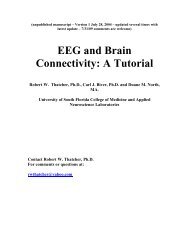Myotrac Infiniti Rehab Suite w/Incontinence - User Manual
Myotrac Infiniti Rehab Suite w/Incontinence - User Manual
Myotrac Infiniti Rehab Suite w/Incontinence - User Manual
Create successful ePaper yourself
Turn your PDF publications into a flip-book with our unique Google optimized e-Paper software.
2. Rest-work cycle: Divided into 2 steps and repeated 10 times:<br />
a. Rest: Relax muscles for 10 seconds.<br />
b. Work: Contract and hold for 10 seconds.<br />
3. Post baseline: Relax muscles to determine new resting levels; duration is 60 seconds.<br />
Note that channel B is dedicated to the monitoring of the abdominal muscles, which have to remain relaxed<br />
when the pelvic muscles (channel A) are contracted.<br />
1a. Verify signal 1b. Instructions 1c. Pre-baseline<br />
2. Rest-Work 3. Post baseline<br />
This sample script was provided by the Biofeedback Foundation of Europe; designed by Nancy Schully.<br />
At the end of the session, you can enter session notes (see Stopping a Session, page 7). You can then<br />
review the session with the screen R 2Ch Report-Review PMD 10-10sec 10 cycles in the category <strong>Rehab</strong><br />
<strong>Suite</strong> – Report-Review and generate a session report. To learn how to review a session and create a<br />
report, please read Reviewing Sessions, page 8.<br />
PERINEAL TRAINING WITH TEMPLATE (SCRIPTS)<br />
This is a series of work-rest and training scripts focusing on perineal reeducation. The scripts in the first<br />
section provide short exercise sessions (1 to 2 minutes) with simple templates. The scripts in the second<br />
section are longer sessions with complex templates and they can be used in the design of a treatment<br />
program.<br />
Templates give a means of setting a goal line that varies in the type of contractions to be done. In a sense<br />
they provide a lesson plan for the patient to follow as opposed to having the exercise verbalized. In general<br />
these templates combine gradual, quick and sustained contractions with gradual and sustained release.<br />
Sharp peaks represent quick contractions; plateaus higher than 2µV are sustained contractions; and<br />
plateaus at 2µV or lower for sustained release/relaxation (this is assuming the resting level is around 2µV).<br />
Naturally, following a template requires practice and precise muscle control. With unstable muscle activity it<br />
is difficult to trace the lines with the EMG signal. For a beginner patient, select a level that they can easily<br />
achieve, that is, a level within the range of their contractions (evaluated with the Maximal Force Assessment<br />
script, for instance). To do this, change the vertical scale maximum value to the patient’s maximal<br />
contraction. Read Adjusting Scales and Threshold, page 11, for more information. Then gradually increase<br />
the level as their skill improves. Different positions can also used to help the muscle in template training.<br />
Work incrementally at each stage starting with the supine position where muscles are relaxed, then the<br />
sitting position where the back muscles come into play, and finally the standing position, which is the most<br />
difficult since more muscles are used to stay upright.<br />
MyoTrac <strong>Infiniti</strong> <strong>Rehab</strong> <strong>Suite</strong> 40
















